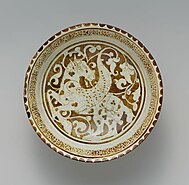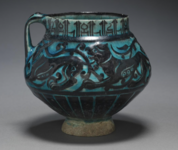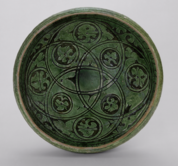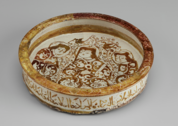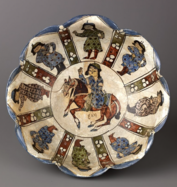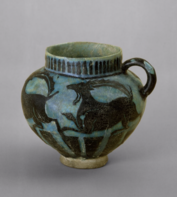325:
632:
226:
339:
62:
334:
358:
206:
176:
345:
260:
77:, or siliceous ware, is that the bonding material is sourced from a liquified glass and refined clay. In all cases, this medium can be dyed, molded by hand, and hardened with firing. As the production of stonepaste accelerated, the ceramics of the Syrian and Persian regions of the Seljuk developed stylistically with greater detail and divergence in ornamentation, such as in
353:
87:(polychrome enamel), and glaze. Luster painting and mina'i both involve painting an overglaze onto a previously glazed and fired stonepaste body at a lower temperature. Lusterware was a costly process that required expertise as it deals with compounds such as metal oxides, sulfur, and a refractive medium in addition to a glaze.
270:
Various types of script templates developed during the Seljuk era among Kofi and Naskh. Kofi script was popular and harmonized well with geometric designs for its dynamic and distinct movement. It was often used in religious context as its symbolic identity alluded to originality, spirituality, and a
255:
Inspired by legends and centered on faith, bird motifs (soul, divinity, human flight) and other animals such as deer (beauty, dignity), peacocks, goats, and rabbit appeared on dishes. Horsemen also emerged in Seljuk pottery with a sense of rotating movement to suggest a cosmic state. Human images
233:
From architecture, it was found that floral ornamentation of the Seljuk period is known for the width of the stems, which are much thinner than their
Abbasid Samarra predecessors. Seljuk vegetal motifs are also characterized by the dimension of the leaves. Leaves are often depicted with elongated
48:
Turko-Persian empire that spanned over
Anatolia to Central Asia between 1037–1194 until the Mongol invasion. Extending from Syria to India, diverse cultures made up Seljuk territory, and as Seljuk rulers adhered and assimilated into Persian-Islamic traditions, Seljuk artwork became an amalgam of
291:
During the Seljuk period, religious identity and teaching exposed urban merchants, traders, craftsmen, and artisans to a broader education, and this group made up the new middle class. With access to luxury goods, this group could not afford to patronize gold and silverware. Hence, enameled and
287:
with a white body but with a loose glaze. Artifacts in Rey and easy production suggest that these pieces were commonly owned by lower classes. Once the stonepaste industry expanded with heightened efficiency (around the twelfth century), ceramic products became more affordable and widespread.
244:(“maker of forms,” or artist) may claim creator-hood. Therefore, it became common practice for Arabic inscriptions themselves to carry the animated spirit; however, by the Seljuk period, human and animal figures gradually emerged. Further, while the Seljuk Empire was officially
315:
by the silk road. Reference and appeal to the
Mongols would be depicted by figures with round faces and almond eyes. Chinese motifs such a phoenixes, dragons, and lotuses occurred in Seljuk ceramic work, and Chinese figures were also portrayed, identifiable by their clothing.
72:
Broadly, Islamic ceramic mediums of the Seljuk region used the principles of glazed composition, where finely powdered quartz would be fused together with a heated bonding agent, typically alkali or lime. What distinguishes
Islamic ceramic mediums, called stonepaste,
324:
221:
Artwork from the Middle East often exhibit vegetal and floral patterns, and this extends to Seljuk pottery. Typically taking ornamental form (decorative artistic expression, not the subject), shapes that resemble plants adorn the margins.
91:
involved layers of pigmented glazes though second firings (commonly with blue, turquoise, and purple as a base layer with a red, black, green, pink, brown, yellow, or white secondary coat), and some pieces were gilded.
195:
technique from the previous period. To execute this type of ceramic ware, glazes of black slip-paint and turquoise ivory would be layered to create patterns, typically that of people, animals, and plants.
510:"Ceramic Technology in the Seljuq Period: Stonepaste in Syria and Iran in the Twelfth and Early Thirteenth Centuries | Essay | The Metropolitan Museum of Art | Heilbrunn Timeline of Art History"
300:
would be a part of the design. Distinctions in ceramic styles diverged with bourgeois "special art" and middle class "common art" becoming more identifiable by the presence of precious metals.
114:
Seljuk pottery came in a variety of forms. So while there are no specific shapes that classify ceramics
Iranian or Seljuk, the following list describes common shapes and types of pottery:
49:
Persian, Islamic, and
Central Asian—Turkic characteristics. In addition to local influences and government support, the hybridity of Seljuk art was also a byproduct of trade from the
292:
decorated pottery, or luster (mina'i) ceramics, became a marker of middle class luxury, became a marker of middle class luxury, expressing both success economically and faith as
102:
in central Iran. Kashan was able to produce fritware due to its location, being near the necessary resources. Luster painting, characterized by an opacified glaze in Kashan, and
771:
703:
401:
53:. Experimentation with various techniques, technology, and styles across Eurasia ultimately resulted in a uniquely "Seljuk style" of ceramics and pottery.
106:, techniques requiring expertise, were associated with the city, and it is theorized that there may have been a monopoly around the twelfth century.
130:
Made of glass paste, has a concave circular base, spherical body, short cylindrical neck and is turned outwards with a decorative handle and groove.
256:
were also then employed to depict activities such as dancing and hunting, court and royal life, as well as to illustrate mythological stories.
844:
436:
148:
Featured by a long round base, a spherical body and a neck that is divided into two parts: a cylindrical shape on top of a spherical shape.
271:
firmness. On the other hand, Naskh was known for its more cursive-like aesthetic curvatures that balanced negative and positive space.
202:
Excavations have shown that Kashan, Rey, Gurgan (Jorjan) and
Nishabur and Sirjan were major centers for making this type of pottery.
240:
Figural representation in the
Islamic world coexisted with resistance and anxiety in the light of potential Qur'anic conflict, as
815:
680:"The Art of the Seljuqs of Iran (ca. 1040–1157) | Essay | The Metropolitan Museum of Art | Heilbrunn Timeline of Art History"
378:"The Art of the Seljuqs of Iran (ca. 1040–1157) | Essay | The Metropolitan Museum of Art | Heilbrunn Timeline of Art History"
328:
Turquoise Bowl with Lute Player and
Audience. Late 12th–early 13th century. Iran. Stonepaste; glazed. H. 8.9 cm, D. 19.7 cm.
229:
Bowl with
Courtly and Astrological Motifs. Late 12th–early 13th century. Northern Iran, Seljuq period. H. 9.5cm, D. 18.7 cm.
279:
Before the spread of stoneware and glazing techniques, one of the easiest forms of pottery to manufacture was called
655:"Figural Representation in Islamic Art | Essay | The Metropolitan Museum of Art | Heilbrunn Timeline of Art History"
303:
As the Seljuk economy stabilized, cultural exchange also played a part in directing ceramic style. Motifs from the
742:"The study of the Structure and Articulation of "Human-Script" Compound in the Artificial Arts of the Seljuk Era"
65:
Late 12th century. Made in Iran. Stonepaste; luster-painted on opaque monochrome glaze. H. 8.3 cm, Diam. 20.3 cm.
225:
854:
585:"A Survey on the Decorative Patterns of Silhouette Pottery and its Comparison with Metal Vessels of the Seljuk"
608:"Vegetal Patterns in Islamic Art | Essay | The Metropolitan Museum of Art | Heilbrunn Timeline of Art History"
772:"STUDY OF SOCIOLOGICAL COMPONENTS ON THE EVOLUTION OF POTTERY IN THE SELJUK PERIOD (5TH TO 6TH CENTURY AH)"
249:
722:
136:
These have a tall oval vessel as a body with a short neck and a handle up to the mouth to help drinking.
32:
was able to accelerate in production, which made way for new designs, motifs, and patterns to emerge.
859:
849:
457:
338:
61:
783:
697:
432:
395:
424:
333:
284:
179:
Jug with Running Animals.1150-1220. Iran (Kashan) Seljuk period. Silhouette ware. 13x14 cm.
357:
205:
175:
166:
Closer to the shape of a modern cup with edges turned outwards and an unglazed lower base.
191:
Silhouette pottery techniques developed during the Seljuk period following scratching or
679:
481:
377:
82:
344:
263:
Lustre-Painted Dish, Front. 12th–13th century. Kashan, Iran. Fritware, lustre painted.
142:
With a long, round, concave base and an elongated body that is vertical near the edge.
124:
Characterized by a long and round base, concave body, smooth edge and turned outwards.
838:
654:
607:
509:
41:
416:
312:
259:
234:
proportions and falcate shapes. These themes, notably "Seljuk," recur in ceramics.
98:
Between the 1770s and 1220s, ceramic wares were mainly exported out of the city of
741:
428:
816:"Cultural Selection: Chinese Influences in Anatolian Arts | Silk Roads Programme"
726:
561:
Watson, Oliver (1975). "Persian Lustre-Painted Pottery: Rayy and Kashan Styles".
245:
45:
718:
154:
These have a long circular base, a large spherical body, and an inverted edge.
78:
17:
787:
209:
Bowl with Vegetal Motifs.12th-13th century. Iran, Seljuq period. Earthenware.
352:
192:
50:
584:
304:
74:
308:
297:
252:
presence manifested in its pottery through symbolism and allegories.
99:
770:
Sadaf, Pourmahmoud; Reza, Afhami; Mehdi, Keshavarz Afshar (2022).
293:
633:"Evolution of Abstract Vegetal Ornaments in Islamic Architecture"
719:"Zoroastrian Humanism and its relationship with Seljuk Ceramics"
537:
595:(1): 73–89 – via University of Sistan and Baluchestan.
343:
323:
776:Вестник Санкт-Петербургского университета. Искусствоведение
28:Characterized by lusterware and mina'i techniques,
288:However, this did not "level-out" social classes.
423:, Cambridge University Press, pp. 203–282,
640:International Journal of Architectural Research
563:Transactions of the Oriental Ceramic Society 40
417:"The Internal Structure of the Saljuq Empire"
8:
702:: CS1 maint: multiple names: authors list (
400:: CS1 maint: multiple names: authors list (
684:The Met’s Heilbrunn Timeline of Art History
659:The Met’s Heilbrunn Timeline of Art History
612:The Met’s Heilbrunn Timeline of Art History
514:The Met’s Heilbrunn Timeline of Art History
382:The Met’s Heilbrunn Timeline of Art History
589:Iranian Journal of Archaeological Studies
678:Komaroff, Authors: Suzan Yalman, Linda.
376:Komaroff, Authors: Suzan Yalman, Linda.
258:
224:
204:
174:
60:
368:
765:
763:
761:
759:
695:
393:
653:Art, Authors: Department of Islamic.
606:Art, Authors: Department of Islamic.
578:
576:
574:
572:
531:
529:
503:
501:
482:"Collections Online | British Museum"
307:were introduced with exposure to the
7:
804:. A.C.S. Peacock. 2015. p. 289.
536:Foundation, Encyclopaedia Iranica.
538:"Welcome to Encyclopaedia Iranica"
160:Round with a shallow concave base.
25:
415:Lambton, A. K. S. (1968-01-01),
356:
351:
337:
332:
1:
429:10.1017/chol9780521069366.003
421:The Cambridge History of Iran
128:Stoup, Flagon, Ewer, Pitcher:
845:Pottery of the Seljuk Empire
57:Technology and manufacturing
717:Abolghasem, Dadvar (2023).
508:Rugiadi, Authors: Martina.
876:
631:Abdullahi, Yahya (2015).
171:Themes, motifs, and style
740:Taheri, Alireza (2017).
214:General stylistic trends
802:The Great Seljuk Empire
348:
329:
264:
230:
210:
180:
152:Small crock, Vat, Jar:
70:Summary of Development
66:
42:Seljuk (Seljuq) Empire
486:www.britishmuseum.org
347:
327:
275:Economic implications
262:
228:
208:
178:
64:
583:Behnia, Ali (2021).
462:www.unesco-iicas.org
313:Chinese Song Dynasty
36:History and context
349:
330:
296:script and Arabic
265:
238:Humans and Animals
231:
211:
184:Silhouette pottery
181:
164:Drinking Utensils:
67:
542:iranicaonline.org
458:"Seljuk ceramics"
438:978-1-139-05497-3
285:Chinese porcelain
283:, which imitated
16:(Redirected from
867:
830:
829:
827:
826:
812:
806:
805:
798:
792:
791:
767:
754:
753:
737:
731:
730:
714:
708:
707:
701:
693:
691:
690:
675:
669:
668:
666:
665:
650:
644:
643:
637:
628:
622:
621:
619:
618:
603:
597:
596:
580:
567:
566:
558:
552:
551:
549:
548:
533:
524:
523:
521:
520:
505:
496:
495:
493:
492:
478:
472:
471:
469:
468:
454:
448:
447:
446:
445:
412:
406:
405:
399:
391:
389:
388:
373:
360:
355:
341:
336:
21:
875:
874:
870:
869:
868:
866:
865:
864:
855:Islamic pottery
835:
834:
833:
824:
822:
814:
813:
809:
800:
799:
795:
769:
768:
757:
739:
738:
734:
716:
715:
711:
694:
688:
686:
677:
676:
672:
663:
661:
652:
651:
647:
635:
630:
629:
625:
616:
614:
605:
604:
600:
582:
581:
570:
560:
559:
555:
546:
544:
535:
534:
527:
518:
516:
507:
506:
499:
490:
488:
480:
479:
475:
466:
464:
456:
455:
451:
443:
441:
439:
414:
413:
409:
392:
386:
384:
375:
374:
370:
366:
322:
277:
248:, the region's
216:
186:
173:
112:
110:Formal typology
79:luster painting
59:
38:
27:
23:
22:
15:
12:
11:
5:
873:
871:
863:
862:
857:
852:
847:
837:
836:
832:
831:
807:
793:
782:(4): 666–681.
755:
732:
709:
670:
645:
623:
598:
568:
553:
525:
497:
473:
449:
437:
407:
367:
365:
362:
321:
318:
276:
273:
250:Zoroastrianism
215:
212:
185:
182:
172:
169:
168:
167:
161:
155:
149:
143:
137:
131:
125:
111:
108:
58:
55:
37:
34:
30:Seljuk pottery
24:
18:Seljuq pottery
14:
13:
10:
9:
6:
4:
3:
2:
872:
861:
858:
856:
853:
851:
848:
846:
843:
842:
840:
821:
820:en.unesco.org
817:
811:
808:
803:
797:
794:
789:
785:
781:
777:
773:
766:
764:
762:
760:
756:
751:
747:
743:
736:
733:
728:
724:
720:
713:
710:
705:
699:
685:
681:
674:
671:
660:
656:
649:
646:
641:
634:
627:
624:
613:
609:
602:
599:
594:
590:
586:
579:
577:
575:
573:
569:
564:
557:
554:
543:
539:
532:
530:
526:
515:
511:
504:
502:
498:
487:
483:
477:
474:
463:
459:
453:
450:
440:
434:
430:
426:
422:
418:
411:
408:
403:
397:
383:
379:
372:
369:
363:
361:
359:
354:
346:
342:
340:
335:
326:
319:
317:
314:
310:
306:
301:
299:
295:
289:
286:
282:
274:
272:
269:
261:
257:
253:
251:
247:
243:
239:
235:
227:
223:
220:
213:
207:
203:
201:
197:
194:
190:
183:
177:
170:
165:
162:
159:
156:
153:
150:
147:
144:
141:
138:
135:
132:
129:
126:
123:
120:
117:
116:
115:
109:
107:
105:
101:
97:
93:
90:
86:
85:
80:
76:
71:
63:
56:
54:
52:
47:
43:
35:
33:
31:
19:
823:. Retrieved
819:
810:
801:
796:
779:
775:
749:
746:Bagh-e Nazar
745:
735:
712:
687:. Retrieved
683:
673:
662:. Retrieved
658:
648:
639:
626:
615:. Retrieved
611:
601:
592:
588:
562:
556:
545:. Retrieved
541:
517:. Retrieved
513:
489:. Retrieved
485:
476:
465:. Retrieved
461:
452:
442:, retrieved
420:
410:
385:. Retrieved
381:
371:
350:
331:
302:
290:
280:
278:
267:
266:
254:
241:
237:
236:
232:
218:
217:
199:
198:
188:
187:
163:
158:Plate, Dish:
157:
151:
145:
139:
133:
127:
121:
118:
113:
103:
95:
94:
88:
83:
69:
68:
46:Sunni Muslim
39:
29:
26:
860:Persian art
850:Turkish art
268:Calligraphy
839:Categories
825:2024-03-07
727:2868320469
689:2024-03-20
664:2024-03-20
617:2024-03-20
547:2024-03-20
519:2024-02-20
491:2024-02-20
467:2024-02-20
444:2024-03-07
387:2024-02-20
364:References
788:2221-3007
752:(54): 49.
193:Sgraffito
122:(beaker):
51:Silk Road
723:ProQuest
698:cite web
565:: 65–66.
396:cite web
305:Far East
294:Quaranic
242:musawwir
200:Location
75:fritware
320:Gallery
309:Mongols
298:hadiths
146:Carafe:
134:Bottle:
786:
725:
435:
219:Plants
189:Method
104:mina'i
100:Kashan
96:Kashan
89:Mina'i
84:mina'i
44:was a
642:: 35.
636:(PDF)
246:Sunni
140:Bowl:
784:ISSN
704:link
433:ISBN
402:link
311:and
281:qoli
40:The
425:doi
119:Cup
841::
818:.
780:12
778:.
774:.
758:^
750:14
748:.
744:.
721:.
700:}}
696:{{
682:.
657:.
638:.
610:.
593:11
591:.
587:.
571:^
540:.
528:^
512:.
500:^
484:.
460:.
431:,
419:,
398:}}
394:{{
380:.
81:,
828:.
790:.
729:.
706:)
692:.
667:.
620:.
550:.
522:.
494:.
470:.
427::
404:)
390:.
20:)
Text is available under the Creative Commons Attribution-ShareAlike License. Additional terms may apply.
